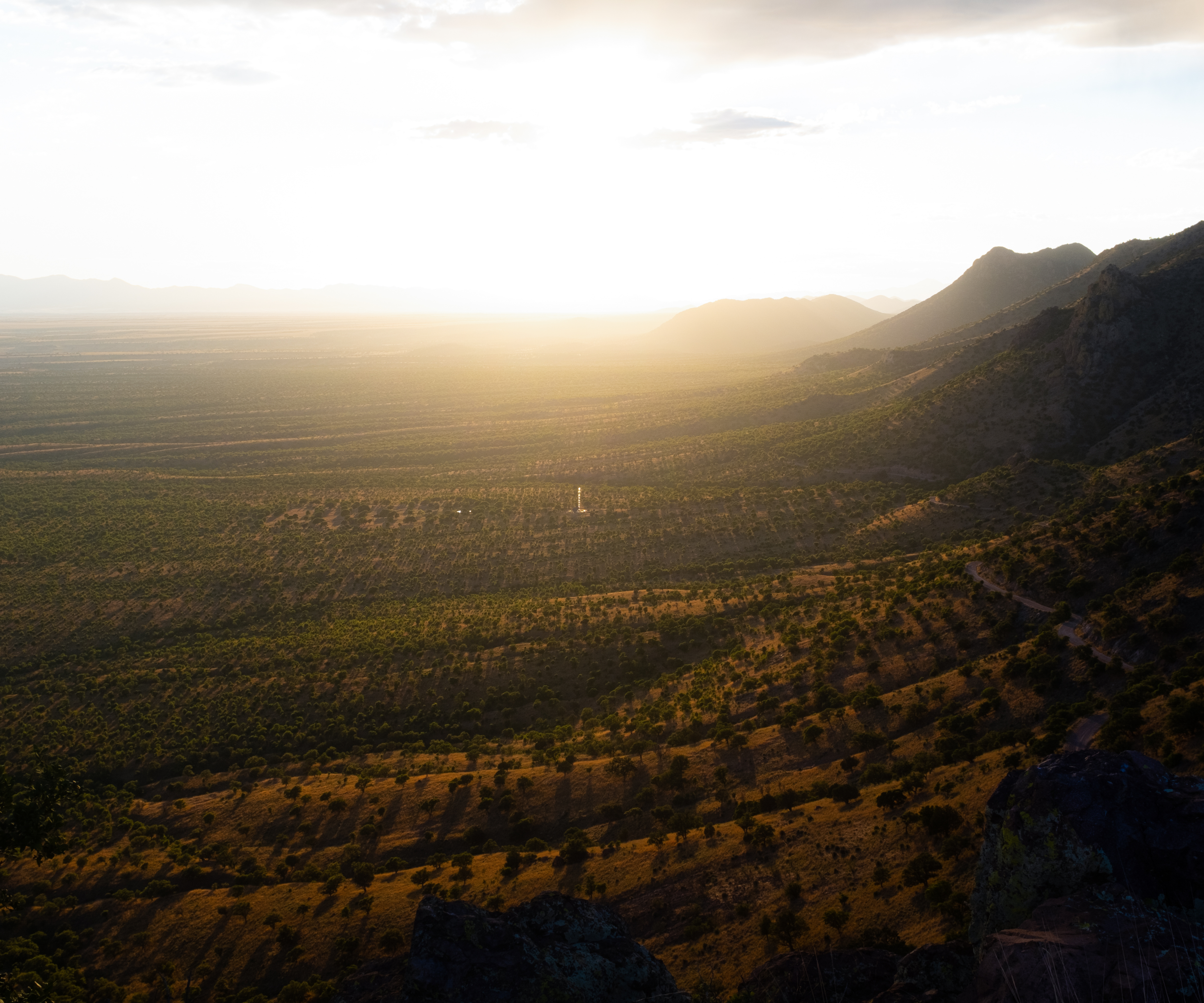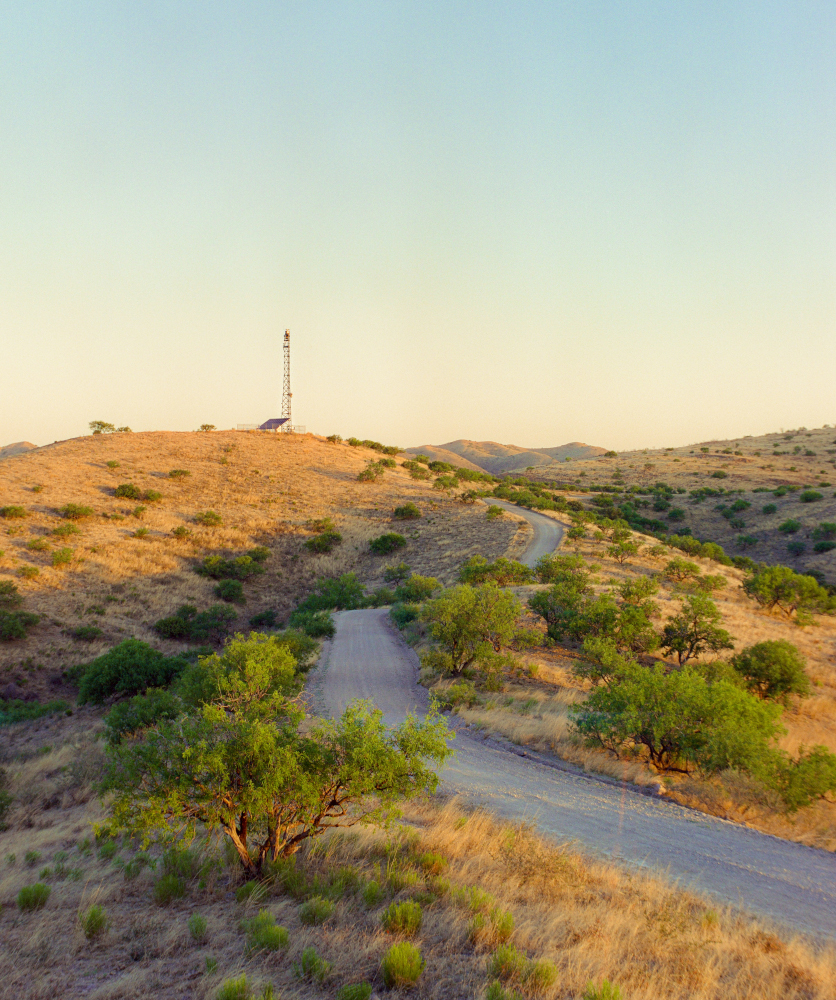"Infrastructures of Control": Q&A with the Geographers Behind University of Arizona's Border Surveillance Photo Exhibition
Guided by EFF's map of Customs & Border Protection surveillance towers, University of Arizona geographers Colter Thomas and Dugan Meyer have been methodologically traversing the U.S.-Mexico border and photographing the infrastructure that comprises the so-called "virtual wall." Anduril Sentry tower beside the Rio Grande River. Photo by Colter Thomas (CC BY-NC-ND 4.0)
From April 12-26, their outdoor exhibition "Infrastructures of Control" will be on display on the University of Arizona campus in Tucson, featuring more than 30 photographs of surveillance technology, a replica surveillance tower, and a blow up map based on EFF's data.
Locals can join the researchers and EFF staff for an opening night tour at 5pm on April 12, followed by an EFF Speakeasy/Meetup. There will also be a panel discussion at 5pm on April 19, moderated by journalist Yael Grauer, co-author of EFF's Street-Level Surveillance hub. It will feature a variety of experts on the border, including Isaac Esposto (No More Deaths), Dora Rodriguez (Salvavision), Pedro De Velasco (Kino Border Initiative), Todd Miller (The Border Chronicle), and Daniel Torres (Daniel Torres Reports).
In the meantime, we chatted with Colter and Dugan about what their project means to them.
MAASS: Tell us what you hope people will take away from this project?
MEYER: We think of our work as a way for us to contribute to a broader movement for border justice that has been alive and well in the U.S.-Mexico borderlands for decades. Using photography, mapping, and other forms of research, we are trying to make the constantly expanding infrastructure of U.S. border policing and surveillance more visible to public audiences everywhere. Our hope is that doing so will prompt more expansive and critical discussions about the extent to which these infrastructures are reshaping the social and environmental landscapes throughout this region and beyond.
THOMAS: The diversity of landscapes that make up the borderlands can make it hard to see how these parts fit together, but the common thread of surveillance is an ominous sign for the future and we hope that the work we make can encourage people from different places and experiences to find common cause for looking critically at these infrastructures and what they mean for the future of the borderlands.
An Integrated Fixed Tower in Southern Arizona. Photo by Colter Thomas (CC BY-NC-ND 4.0)
MAASS: So much is written about border surveillance by researchers working off documents, without seeing these towers first hand. How did your real-world exploration affect your understanding of border technology?
THOMAS: Personally I’m left with more questions than answers when doing this fieldwork. We have driven along the border from the Gulf of Mexico to the Pacific, and it is surprising just how much variation there is within this broad system of U.S. border security. It can sometimes seem like there isn’t just one border at all, but instead a patchwork of infrastructural parts—technologies, architecture, policy, etc.—that only looks cohesive from a distance.
An Integrated Fixed Tower in Southern Arizona. Photo by Colter Thomas (CC BY-NC-ND 4.0)
MAASS: That makes me think of Trevor Paglen, an artist known for his work documenting surveillance programs. He often talks about the invisibility of surveillance technology. Is that also what you encountered?
MEYER: The scale and scope of U.S. border policing is dizzying, and much of how this system functions is hidden from view. But we think many viewers of this exhibition might be surprised—as we were when we started doing this work—just how much of this infrastructure is hidden in plain sight, integrated into daily life in communities of all kinds.
This is one of the classic characteristics of infrastructure: when it is working as intended, it often seems to recede into the background of life, taken for granted as though it always existed and couldn’t be otherwise. But these systems, from surveillance programs to the border itself, require tremendous amounts of labor and resources to function, and when you look closely, it is much easier to see the waste and brutality that are their real legacy. As Colter and I do this kind of looking, I often think about a line from the late David Graeber, who wrote that “the ultimate hidden truth of the world is that it is something that we make, and could just as easily make differently.”
THOMAS: Like Dugan said, infrastructure rarely draws direct attention. As artists and researchers, then, our challenge has been to find a way to disrupt this banality visually, to literally reframe the material landscapes of surveillance in ways that sort of pull this infrastructure back into focus. We aren’t trying to make this infrastructure beautiful, but we are trying to present it in a way that people will look at it more closely. I think this is also what makes Paglen’s work so powerful—it aims for something more than simply documenting or archiving a subject that has thus far escaped scrutiny. Like Paglen, we are trying to present our audiences with images that demand attention, and to contextualize those images in ways that open up opportunities and spaces for viewers to act collectively with their attention. For us, this means collaborating with a range of other people and organizations—like the EFF—to invite viewers into critical conversations that are already happening about what these technologies and infrastructures mean for ourselves and our neighbors, wherever they are coming from.
Friday 5th April 2024 7:50 pm